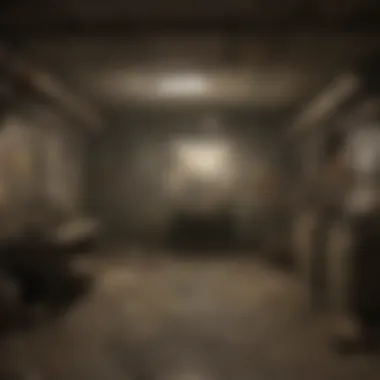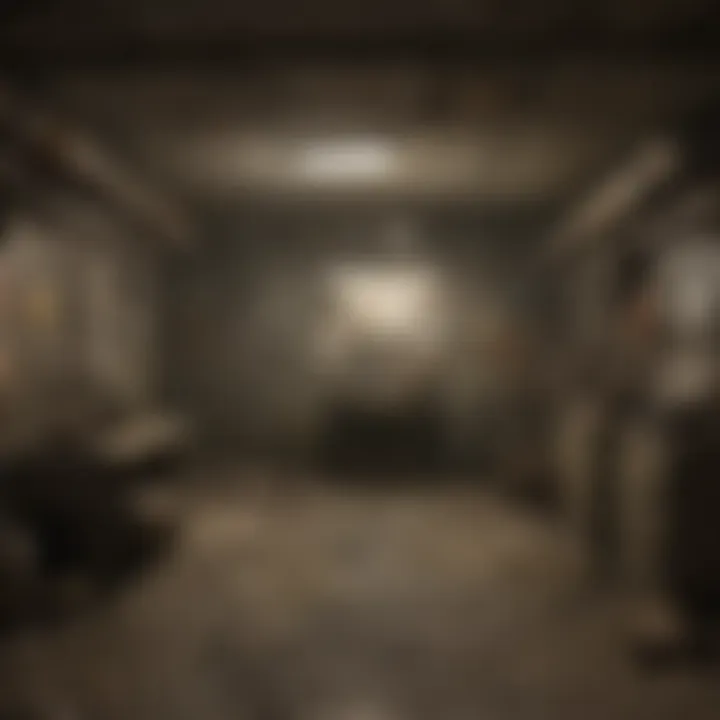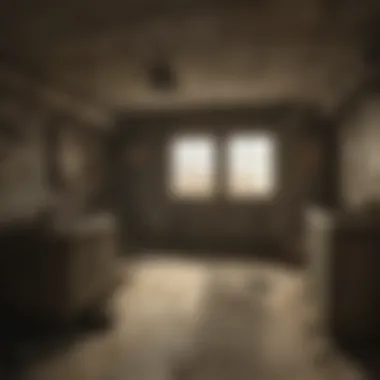Exploring Fallout Bunkers: History, Design, and Impact


Intro
The concept of fallout bunkers holds a significant place in both historical and cultural contexts. Initially, these structures emerged as necessities during the Cold War, offering a means of protection against nuclear fallout. Over time, their representation has evolved beyond mere survival shelters into symbols of various ideologies, most notably within the gaming landscape. This article provides an extensive exploration of fallout bunkers, focusing on their design, underlying purpose, and their cultural significance across different media, particularly the Fallout game series.
The structural integrity and specific designs of bunkers reflect the psychological aspects of survival. The very idea of retreating underground to escape chaos above taps into deep-seated human instincts. Furthermore, in the realm of storytelling, especially in post-apocalyptic narratives, these bunkers serve to highlight themes of isolation, community, and the human will to endure.
As we delve into the evolution of these shelters, we will examine their historical roots and how these factors shaped the design of bunkers. We will also explore the intricate relationship between the portrayal of these structures in games and their real-world implications. This narrative aims to provide a comprehensive understanding of fallout bunkers, enriching the appreciation of both their historical context and cultural impact.
Lore Insights
Overview of the Fallout Universe
The Fallout universe is a richly crafted world set in a post-apocalyptic future, where global nuclear war has drastically altered the landscape. It is characterized by a retro-futuristic aesthetic, where 1950s ideals meet the harsh realities of survival. Central to this universe are the vaults, which are essentially nuclear fallout shelters designed by Vault-Tec Corporation. Each vault serves a unique experiment, often leading to unintended consequences.
Key historical events in the Fallout timeline
The timeline of events leading to the Fallout world includes several pivotal moments:
- The Great War (2077): A rapid escalation of global tensions resulting in nuclear annihilation.
- The formation of various factions such as the Brotherhood of Steel and the Enclave, which have a significant impact on the narrative.
- The emergence of mutated creatures and other hazards in the wasteland.
Each of these events shapes not only the environment but also influences the characters encountered throughout the series.
Deep dive into the backstory of major factions and characters
The factions in the Fallout series are essential for understanding the socio-political dynamics of the game. The Brotherhood of Steel focuses on preserving technology, while the Institute represents advanced science and experimentation. Characters like the Sole Survivor or Vault Dwellers often find themselves caught between these factions, showcasing the struggle for power and survival in a devastated world. Their journeys provide a rich ground for exploration and analysis.
Gameplay Tips and Strategies
Beginner's guide to playing Fallout games
For newcomers to the series, starting can be overwhelming. Here are some basic tips to navigate the gameplay:
- Explore thoroughly: The wasteland is vast, and many quests and items are hidden. Don't rush through the main storyline.
- Invest in skills: Focus on stats that align with your playstyle, whether melee combat, hacking, or diplomacy.
- Manage resources wisely: Scavenging is critical, so prioritize finding ammunition and crafting materials.
Weapon and armor recommendations
Choosing the right gear is essential for survival. Weapons like the 10mm Pistol and Combat Shotgun are reliable early options. For armor, consider light armor for agility and stealth or heavier armor for robust protection in combat situations.
Tips for efficient resource management
Gather every item you find; you never know when something may become useful. Convert scrap materials into useful components for crafting. Prioritize food and water to maintain health and stamina for longer expeditions.
Character Analysis
Detailed profiles of iconic characters
Characters like Nathaniel "Nate" and Nora represent the modern survivor's journey, while Elder Maxson of the Brotherhood showcases a mix of idealism and militarism. Their backstories enrich the Fallout experience, making player choices more meaningful.
Relationships between characters in the Fallout series
Relationships often fluctuate between allies and rivals, impacting the gameplay and narrative. For instance, the conflict between The Railroad and The Institute illustrates the clash of ideals in a fractured world.
Character development and evolution across games
Characters evolve based on player choices, leading to varying outcomes and narratives. Choices made in earlier games may affect later storylines, creating a rich tapestry of interconnections that deepen player engagement.
News and Updates
Latest announcements from game developers
The development team at Bethesda frequently releases updates regarding gameplay patches and new content. Staying connected through official forums ensures players are informed.
Patch notes and upcoming releases
With each major update, developers often include balance changes and improvements. Regularly check patch notes for details on gameplay enhancements.
Community events and tournaments
Participating in community events can enhance the player experience. Competitive events often spawn rich discussions and offer rewards for participation.


Fan Theories and Speculations
Popular fan theories about the Fallout universe
Fans often speculate about hidden lore and connections in the universe. Theories concerning the fate of certain factions or unexplained events enrich the overall narrative.
Discussion on unresolved plot points
Many unresolved questions linger in the Fallout series, such as the ultimate fate of the Vaults. Discussions among fans contribute to ongoing interest in the franchise, even years after a game's release.
Predictions for future installments in the series
As fans eagerly await new releases, predictions abound regarding potential locations and storylines in future games. The evolving nature of the series keeps fan engagement vibrant and dynamic.
Historical Context of Fallout Bunkers
Fallout bunkers are more than just underground structures; they are a reflection of historical events and societal fears. Understanding their historical context provides insights into why these bunkers were constructed and their significance in both real and fictional realms. The Cold War era is a critical period that fueled the need for such shelters. This context shaped not only the designs of the bunkers but also the cultural narratives surrounding them.
Origins during the Cold War
The Cold War period, marked by geopolitical tension between the Soviet Union and the United States, prompted widespread concern about nuclear conflict. This anxiety led to government initiatives aimed at protecting civilians. During the late 1940s and 1950s, many families constructed their own bomb shelters, while governments built larger-scale fallout bunkers designed to withstand nuclear blasts. The popularization of nuclear drills in schools educated the public about survival strategies in the event of an attack, embedding the concept of the bunker into American culture.
Various designs of these bunkers can be traced back to this era, with most focused on durability and functionality. Common materials such as reinforced concrete were used, ensuring a level of safety from potential fallout. Public awareness campaigns, educational materials and even films contributed to the cult of preparedness that arose during this time. People started viewing these bunkers as necessary, albeit grim, preparations for impending doom.
Evolution Post-Cold War Era
After the dissolution of the Soviet Union, the immediate threat of nuclear war diminished. However, interest in fallout bunkers did not entirely wane. The 1990s and early 2000s saw a revival of bunker interest, fueled by new threats including terrorism and natural disasters. Additionally, the rise of the internet led to communities of survivalists who shared blueprints and strategies for bunker construction. These bunkers evolved from purely defensive structures into multifunctional spaces designed for self-sufficiency and long-term living.
Today, companies like Rising S Bunkers and Vivos provide commercially constructed bunkers, catering to an increasing desire for personal security in an uncertain world. This evolution is not only a response to practical needs but also reflects changing societal attitudes towards safety and preparedness. The timeline of fallout bunkers shows how fears can shape architecture and cultural values over time.
In summary, exploring the historical context of fallout bunkers reveals how they are deeply intertwined with human fears, perpetuating motifs of survival and preparedness that resonate in both reality and media portrayal. This foundation lays the groundwork for understanding how these structures influence and are influenced by cultural and psychological themes.
Structural Designs of Fallout Bunkers
Understanding the structural designs of fallout bunkers is crucial, as it provides insight into their effectiveness and adaptability. The design of a bunker is directly linked to its purpose, which includes protection from environmental threats, sustainable living during a crisis, and psychological well-being. When investigating these shelters, one must consider the materials used in their construction, the layout that facilitates functionality, and the systems for ventilation and sustainability. Each of these elements contributes to the overall resilience and practicality of a bunker.
Materials Used in Construction
In constructing fallout bunkers, the choice of materials is paramount. They must withstand extreme conditions, including potential nuclear fallout. Common materials include reinforced concrete and steel. These materials offer both durability and protection.
- Reinforced Concrete: This is often used for walls and ceilings. Its density provides excellent shielding against radiation.
- Steel: Employed for doors and structural elements, steel adds strength and integrity to the bunker design.
- Lead Lined Components: In some advanced designs, lead is used to provide additional radiation protection.
The use of creative materials can also enhance the aesthetics while keeping safety in mind. Modern advancements have introduced new composite materials, which are lightweight yet extremely strong.
Layout and Functionality
The layout of a fallout bunker is designed for optimal functionality. The internal arrangement needs to maximize space while ensuring that essential functions can occur simultaneously. Typically, key areas within a bunker include:
- Living Quarters: Comfortable enough for long-term stay.
- Storage Areas: For food, water, and equipment.
- Decontamination Zones: Essential for safety upon re-entry into a contaminated environment.
In addition, a well-planned layout enables effective routing of essential systems, such as plumbing and electrical networks. Having these systems well integrated prevents failures during crucial moments.
Ventilation and Sustainability
Ventilation plays a vital role in the overall design of fallout bunkers. Poor air quality can lead to numerous health issues, which is why it is an essential part of bunker planning.
- Air Filtration Systems: These systems should filter out dust, pathogens, and radiation particles from the air.
- Natural Ventilation: Some designs incorporate passive ventilation techniques to reduce reliance on mechanical systems, preserving energy.
Sustainability is also an important aspect. Integrating renewable energy sources, such as solar panels, can ensure self-sufficiency. Water recycling and waste management systems can sustain life for extended periods, hence providing an essential layer of security.
"A well-designed fallout bunker not only protects individuals from immediate threats but also supports long-term survival through thoughtful planning and resource management."
Functional Purpose of Fallout Bunkers
Fallout bunkers hold significant functional value, particularly in times of crisis. These structures serve as protective shelters designed to insulate occupants from various threats, notably nuclear fallout, but also natural disasters and societal collapse. Their engineering focuses on security, resource containment, and the viability of long-term sheltering. Understanding the functional purpose of bunkers illuminates the strategic mindset behind their design and usage.
Safe Havens in a Nuclear Crisis
As the Cold War escalated, the threat of nuclear warfare became a profound concern. Fallout bunkers emerged as vital safe havens during such crises, providing much-needed protection. The design of these bunkers is robust, often reinforced with thick concrete and steel materials to sustain direct blasts and shield occupants from radiation. The philosophy underpinning these constructions is simple: survival amidst chaos.
The air filtration systems installed in these bunkers ensure that even in the direst scenarios, clean air is preserved. \nMoreover, the stocked supplies, including food and water, are essential components complementing the structural defenses. Bunkers are made to sustain life for extended periods, enabling families or groups to remain safe until outside conditions stabilize. This capability is a crucial factor in their design.


The psychological impact of knowing a safe haven exists can not be understated. During panic, the sense of security such a bunker offers can reduce stress and provide a form of control in uncertain times.
"Fallout bunkers symbolize human resilience, reflecting our instinct is to preserve life even in the face of annihilation."
Long-term Survival Strategies
The functionality of a fallout bunker extends beyond mere protection; it focuses on long-term survival. In scenario where occupants may be forced to stay underground for months or years, several strategies come into play. First, creating a sustainable environment is essential. This encompasses waste management, air purification, and perhaps even aquaponics or hydroponics for food supply.
Occupants must also consider psychological health. When confined in limited space, maintaining mental well-being involves establishing routines, engaging in recreational activities, and social interactions among group members. Therefore, a well-designed bunker emphasizes not only physical survival but also mental resilience.
Fallout Bunkers in the Fallout Game Series
The representation of fallout bunkers in the Fallout game series plays a crucial role in conveying the themes and mechanics inherent in the franchise. These bunkers, often referred to as Vaults, are not merely functional spaces but are central to the plot and world-building. They serve as contrasts to the wastelands outside, creating a setting that explores human behavior, societal structures, and survival against a backdrop of nuclear devastation. Players quickly find that the bunkers in Fallout are more than just hiding places; they are reflections of human ingenuity and folly.
Representation of Bunkers in Gameplay
In gameplay, bunkers serve as essential locations for exploration and storytelling. Each Vault is uniquely designed, carrying its own narrative that unfolds as the player interacts with it. These narratives can range from experiments gone awry to utopian ideals that consider how society might react in a crisis. The player's journey through each bunker typically reveals secrets and lore that enrich the overall narrative of the Fallout universe.
- Unique Design: Each bunker has its distinct architectural style and layout, giving insight into the societal values of its inhabitants. For instance, Vault 111 features a focus on cryogenic preservation, reflecting humanity's fear of the unknown.
- Engagement with NPCs: Many bunkers contain non-player characters who provide crucial information and quests, adding depth to player interactions. This highlights the cultural significance of vault living in the game.
- Resources and Crafting: The bunkers often contain resources essential for crafting and survival, allowing players to strategize their playstyle effectively. Players must decide how to manage what they find to thrive in the post-apocalyptic world.
Bunker Design Influences in the Fallout Universe
The design of bunkers in the Fallout universe draws from a range of real-world influences while incorporating imaginative elements that enhance gameplay. These designs reflect the aesthetics of the 1950s, infused with retro-futurism. The choice of materials, layouts, and technology signifies a blend of realism and speculative fiction that characterizes the series.
- Influences from Real-World Bunkers: The design often mirrors real-life Cold War shelters, emphasizing practical safety features with an unsettling twist. For instance, the use of heavy steel and concrete showcases survivalist engineering, while the interiors evoke a sense of nostalgia that contrasts sharply with the chaos of the outside world.
- Cultural References: Players can spot nods to various aspects of popular culture within these environments. The way in which vaults are presented often comments on contemporary fears surrounding nuclear war and irresponsible governmental practices.
- Environmental Storytelling: The clutter and arrangement within each bunker often tell their own stories. Items scattered around, along with visual cues, provide deeper context about the life and struggles of those who once inhabited these spaces.
This intricate design of bunkers in the Fallout game series fosters a connection between the player and the world, reminding us of the delicate balance between humanity's aspirations and its fallibility.
Cultural Significance of Fallout Bunkers
The cultural significance of fallout bunkers extends beyond their basic architectural function. These structures embody a deep-seated fear of nuclear devastation, simultaneously reflecting a sense of preparedness and a fascination with apocalyptic scenarios. Bunkers serve as a physical representation of societal anxieties, where survivalist ideologies blend with the imaginative realms of both real and fictional narratives. As such, they hold a substantial place in the collective consciousness of many, particularly within the context of survivalism and video gaming.
Portrayal of Survivalist Ideologies
Survivalist ideologies have gained considerable traction in modern society, and fallout bunkers are central to this phenomenon. The belief that society could collapse due to a catastrophic event has led to an increase in interest surrounding self-sufficiency and preparedness strategies. Fallout bunkers symbolize the desire for security in volatile times, illustrating the lengths to which individuals will go to ensure their survival. In popular media, particularly in the Fallout game series, these ideologies are reinterpreted, allowing players to engage with scenarios that reflect extreme survivalist beliefs.
In these narratives, players often find themselves facing moral dilemmas, forcing them to question their own values in crises. The challenges of resource management and group dynamics in such a hostile environment resonate with real-world concerns about societal stability and personal safety. Therefore, bunkers represent more than just physical shelters; they encapsulate a mindset about life, risk, and the human condition in uncertain times.
Psychological Impact on Players
The psychological impact of interacting with fallout bunkers in gaming is noteworthy. Players often experience a range of emotions that stem from the themes of survival and resilience. The act of exploring these virtual bunkers can invoke feelings of anxiety, curiosity, and a sense of achievement as players navigate through environments that reflect their deepest fears regarding survival.
Moreover, the immersive nature of the Fallout series encourages players to connect with their characters on a personal level. Decisions made within these safe yet claustrophobic environments challenge players to reflect on their own sense of morality and decision-making under pressure. This can create a powerful bond between the player and the virtual world, resulting in lasting impressions that extend beyond gaming.
In much the same way, the narratives surrounding bunkers in Fallout resonate with real-world fears of disaster. They highlight human resilience in the face of adversity, prompting introspection about the human psyche's capability to cope. This duality—fear of disaster and the drive to overcome—heightens the cultural relevance of bunkers in both gaming and society.
"Fallout bunkers not only serve as physical refuges but also as mirrors reflecting societal fears and aspirations toward survival."
Player Interaction with Bunkers
The concept of player interaction with bunkers plays a critical role in both understanding their design and acknowledging their significance in gameplay. In the Fallout series, bunkers are not mere structures; they serve as microcosms of survival and resource management. Players engage with these environments in dynamic ways, which enhance both the narrative experience and the mechanics of the game.
Bunkers provide players with a sense of exploration. Each bunker often conceals history and resources, compelling players to investigate. Discovering hidden rooms, items, or lore creates a richer gaming experience. This exploration mirrors real-life survival ideologies, where knowledge and resourcefulness are key. Players learn to appreciate the value of their surroundings. Thus, exploration fosters a vital connection between the player and the game's world.
Furthermore, bunkers serve as safe havens within chaotic environments. These environments allow players a brief respite from hostile creatures and factions. Players often find themselves managing health, ammunition, and other essential resources while inside a bunker.
The added layer of strategy complicates interactions with bunkers. Players must consider resource allocation and preservation for long-term survival. This strategic resource management not only influences gameplay but promotes critical thinking and planning. In that sense, bunker interaction reflects survivalist themes prominent in the franchise, making each decision consequential.
"Players in the Fallout series do not merely traverse bunkers; they inhabit them, shaping their strategies and tales through active decision-making."
Exploration and Discovery
Exploration within bunkers is fundamental to gameplay. Upon entering a bunker, players are greeted not just with walls but with potential stories and hidden treasures. Each bunker is meticulously designed to encourage players to search every nook and cranny.
- Players might find:
- Ammunition caches
- Health packs
- Unique items or upgrades
- Lore-related documents
Engaging with these elements can culminate in rewarding experiences. Expanded knowledge of the game world emerges as players piece together narratives from the discoveries they make. This establishes a deeper connection to the game as the player progresses.


Strategic Resource Management
Resource management within bunkers represents one of the most essential aspects of player interaction. Each bunker requires players to make decisions regarding limited supplies.
- Considerations include:
- Which resources to prioritize—food, water, or medical supplies?
- How to manage space effectively for inventory items?
Such planning is crucial due to the scarcity of resources throughout the game. Players are compelled to assess their needs and make informed decisions about what to carry. This management system becomes a central gameplay element, adding tension and engagement. Through these mechanics, bunkers transform from mere shelters into strategic hubs where critical choices shape the player's journey.
Real-World Bunker Culture
In exploring the real-world bunker culture, it is essential to understand its significance and how it connects to broader societal trends. Fallout bunkers have moved beyond mere symbols of paranoia in times of geopolitical tension. They represent a growing interest in self-sufficiency and resilience in the face of uncertain futures. As people increasingly confront environmental disasters, economic instability, and political unrest, the relevance of fallout bunkers has certainly grown.
Survivalists and Preparedness
Survivalism and preparedness cultures have gained traction over recent years. Many adherents emphasize the importance of foreseeing potential crises, whether they be natural disasters, pandemics, or societal breakdowns. Bunkers serve as physical manifestations of these beliefs. Individuals invest significant resources in constructing durable shelters designed to withstand various threats while reinforcing their preparedness mindset.
Key elements of survivalists organizing around bunker culture include:
- Knowledge Acquisition: Learning about self-defense, resource management, and emergency planning is foundational. Many survivalists engage in communities where they share insights for optimal preparedness.
- Location Selection: The placement of bunkers often reflects strategic considerations. Livability alongside accessibility to resources plays a large role in decisions.
- Mental Preparedness: Many emphasize psychological resilience, enhancing skills for coping during crises.
Architectural features of survivalist bunkers can range from simple kits to elaborate complexes. Practical benefits include protection, resource storage, and sometimes, community spaces for group survival.
Commercial Bunker Construction
The commercial aspect of bunker construction shows a blossoming industry catering to an expanding clientele. Various companies specialize in designing and building custom bunkers, often incorporating advanced technologies and robust materials. Bunkers are advertised not only for their protective qualities but also for their capacity to be functional and livable.
Some factors of interest in commercial bunker construction comprise:
- Design Customization: Buyers can choose specific features, such as ventilation systems, water purification methods, and energy sources to suit their personal needs.
- Cost Variability: Prices can range vastly, depending on material choices and design complexities. Investors need to weigh the financial implications against the benefits of having a secure space.
- Living Conditions: Modern bunker designs often prioritize comfort alongside functionality. This includes considerations for air quality, light, and space utilization to aid mental well-being during potential extended stays.
"As societies become more anxious about potential crises, the interest in commercial bunkers reflects a blend of fear and hope for the future."
In summary, real-world bunker culture merges preparedness ideology with practical living solutions. Its rise resonates deeply within a segment of the population seeking assurance amid unpredictability.
Future of Fallout Bunkers in Media
The future of fallout bunkers in media is a topic that resonates with both gamers and enthusiasts of post-apocalyptic themes. As we look ahead, it is essential to consider how these representations might evolve in gaming and broader popular culture. This understanding can help contextualize how audiences engage with the concept of bunkers, both in entertainment and real-life preparedness.
Evolving Narratives in Gaming
Gaming narratives have consistently transformed with technological advancements and changing cultural sentiments. Fallout, as a franchise, has been at the forefront of shaping these dialogues. Future installments are expected to further explore the complexities of bunker life within their narratives.
The rise of open-world mechanics has allowed players to engage deeply with their environments. This includes delving into bunker systems that provide not just shelter, but also intricate quest lines and moral dilemmas. Players can anticipate experiences that have greater emphasis on resource management and survival strategies.
Such futures might also emphasize the psychological aspect of being in a bunker. Story arcs could revolve around the social dynamics of different character types interacting in underground environments. Developers will likely continue to use bunkers as a microcosm for broader societal issues, allowing for narrative experimentation that deeply engages the player. The shift towards multiplayer experiences may also redefine how choosing to inhabit a bunker affects social interactions among players.
Influence on Popular Culture
Bunkers, as a concept, extend beyond the realm of gaming and influence popular culture significantly. The increasing public interest in survivalism contributes to how these shelters are portrayed in various forms of media. This interest has given rise to documentaries, movies, and even reality shows that focus on survivalist lifestyles and bunker preparations.
- Examples of such influences are:
- Movies like "10 Cloverfield Lane" that integrate bunker themes into suspenseful storytelling.
- TV series that highlight how individuals prepare for apocalyptic scenarios often feature bunker setups.
As cultural narratives around emergencies and survival continue to thrive, the portrayal of bunkers will inevitably adapt. They will likely serve as symbols of hope or despair, depending on the story being told. This duality can enrich the public's understanding of their importance in both fictional and potential real-life scenarios.
The representation of bunkers in media reflects the anxieties and fascinations of society, shaping public perceptions around survival and its implications.
Epilogue: Reflections on Fallout Bunkers
The topic of fallout bunkers serves as a vital narrative in exploring human preparedness and cultural representation. These structures are not simply architectural feats; they reveal much about societal anxiety, survival instinct, and the lengths to which people will go to protect themselves. Examining the dual existence of fallout bunkers—both real and fictional—highlights their significance across different contexts, from historical crises to modern gaming.
Bunkers as a Symbol of Human Resilience
Fallout bunkers epitomize the concept of human resilience. They are more than just shelters; they symbolize hope in the face of potential catastrophe. Throughout history, when faced with the threat of nuclear war, the idea of constructing bunkers emerged as a practical solution that reassured many. Each bunker, whether simple or elaborately engineered, represents an effort to safeguard life against overwhelmingly destructive forces.
For those living in environments characterized by instability, these bunkers became a refuge. They embody a proactive mindset—a refusal to succumb to fear. By understanding the symbolic weight carried by bunkers, we appreciate how they reflect humanity's enduring spirit of survival. In the realm of the Fallout game series, this symbolism is magnified. Players engage with bunkers not only as physical locations but also as markers of survival and choice in hostile worlds.
Potential Learning from Bunker Concepts
Analyzing fallout bunkers offers multiple insights. First, they prompt us to think critically about our own preparedness strategies in various scenarios. The design principles used in bunkers can educate individuals on effective space utilization, resource management, and long-term sustainability, essential elements in both crisis situations and daily living.
Second, the cultural significance of bunkers fosters discussions about societal values and fears. The juxtaposition of bunkers in reality versus their representation in media, particularly in games like Fallout, illustrates how narratives can influence perception. Players often engage with themes of survivalism, ethics, and morality while navigating through these spaces. This interplay reinforces the idea that, while bunkers provide security, they also provoke contemplation about human nature and societal structure.
By looking at the legacy of fallout bunkers, one gains a holistic understanding of their importance. They invite reflections on not only historical implications but also encourage forward-thinking approaches in a world that seems increasingly uncertain. As symbols of resilience and hubs of learning, fallout bunkers leave a lasting mark on both our psyche and culture.







